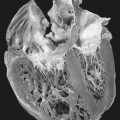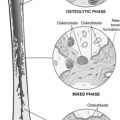72. Pulmonary Arteriovenous Fistula
Definition
Pulmonary arteriovenous fistula (PAVF) is an abnormal communication between the pulmonary arteries and vein. It is typically a congenital anomaly, but may also develop as the result of a number of acquired conditions/diseases. The end result of this communication is a right-to-left shunt.
Conditions Associated with Pulmonary Arteriovenous Fistula Formation
• Actinomycosis
• Fanconi syndrome (see p. 132)
• Hepatic cirrhosis
• Metastatic thyroid carcinoma
• Mitral stenosis
• Schistosomiasis
• Trauma
Incidence
The exact frequency has not been documented because PAVFs have not been carefully studied. In adults PAVF seems to occur more frequently in females than in males by almost a 2:1 ratio; among newborns, males are more frequently affected.
Etiology
The exact cause of PAVF has not been demonstrated. One theory suggests that a defect resulting in dilation of thin capillary sacs occurs in the terminal arterial loop. A different theory suggests the cause may be an incomplete resorption of the vascular septa separating the arterial and venous plexus that would usually anastomose during fetal development. Still another theory points to development of small PAVFs resulting from failure of capillary development during fetal growth.
Signs and Symptoms
• Anemia
• Chest pain
• Congestive heart failure
• Cough
• Cyanosis
• Diplopia
• Dizziness
• Dysarthria
• Dyspnea
• Epistaxis
• Hemoptysis
• Migraine headache
• Syncope
• Tinnitus
• Vertigo
Medical Management
Pharmacologic therapy is not a part of the standard of care for treating PAVF. However, the patient with PAVF definitely needs prophylactic antibiotic therapy before undergoing any dental or surgical procedures. Sporadic reports have advocated use of danazol, octreotide, desmopressin, or aminocaproic acid to treat epistaxis or gastrointestinal hemorrhage in patients with PAVF. The definitive treatment for PAVF is either therapeutic embolization or surgical resection.
Indications for Embolotherapy or Surgical Resection to Treat Pulmonary Arteriovenous Fistula
• Feeding vessels reach circumferences of 3 mm or larger
• Paradoxic embolization
• Progressive lesion enlargement
• Systemic hypoxemia
Complications
• Anemia
• Brain abscess
• Cerebral vascular accident
• Congestive heart failure
• Hemothorax
• Hypoxemia
• Infectious endocarditis
• Massive hemoptysis
• Migraine headache
• Orthodeoxia
• Polycythemia
• Pulmonary hypertension
• Seizure
• Transient ischemic attack
Complications from Therapeutic Embolization
• Air embolism
• Blood vessel rupture
• Bradydysrhythmia
• Device migration
• Pulmonary infarction
• Tachydysrhythmia
• Vascular occlusion
Anesthesia Implications
The anesthetist has two major concerns when caring for the patient with PAVF. The first involves gas exchange, and the second involves systemic emboli formation. Problems with gas exchange occur because PAVF is a right-to-left shunting of blood, which mixes the deoxygenated blood with oxygenated blood and contributes to the distribution of that mixture throughout the systemic circulation. The anesthetist’s goal is to reduce the flow through the PAVF, in effect, to isolate the fistula to the extent possible. The relative isolation of the fistula can be enhanced by positioning the patient so that the PAVF is not in a dependent position, which will reduce the proportion of blood flow through the fistula, thus reducing the amount of right-to-left shunting and improving oxygenation. The anesthetist should also strive to minimize physiologic factors such as hypoxia and hypercarbia, acidosis, hypothermia, and hyperinflation of the lungs, which increase pulmonary vascular resistance and thus exacerbate the degree of right-to-left shunting via the PAVF. Positive end-expiratory pressure (PEEP) should not be used because it essentially redistributes blood flow in the lungs, thus increasing blood flow through the PAVF and exacerbating the degree of right-to-left shunting.
The anesthetist must realize that the right-to-left shunting via the PAVF bypasses the filtration process provided by the pulmonary vascular tree. As a result, any particulate or inclusion (e.g., air embolus, thrombus) may be shunted into the systemic circulation and produce potentially harmful or fatal consequences, such as a stroke or myocardial infarction. The anesthetist must be meticulous in flushing/removing air from the intravenous tubing, particularly from injection ports and stopcocks.
Resection of the PAVF can result in significant blood loss during surgery. The anesthetist should obtain the best possible intravenous access preoperatively; bilateral large-bore peripheral catheters or, preferably, central venous access plus a single large-bore peripheral intravenous line are indicated. The anesthetist must ensure the capability of rapid infusion of crystalloids, colloids, and/or blood or blood products in anticipation of intraoperative blood losses. Also, because of the potentially rapid fluid shifts involved with resection of the PAVF, the anesthetist should insert an arterial pressure catheter to closely monitor the patient’s blood pressure.
Finally, the anesthetist should use a double-lumen endobronchial tube. The double-lumen tube will provide two advantages: (1) exposure of the surgical site is greatly enhanced, and (2) isolation of the operative lung protects the nonoperative lung from aspiration of blood during the surgical procedure and the reduced air exchange that results.







